Black History Month

Part I
I am mixed blood by birth but my complexion is very light skin. My mother was Native American and European bloodlines. However, I grew up in a very predominately white family with all of the privileges that come with that. Because of this background, I have had to learn what our black brothers and sisters have had to endure through their lives. During the early colony days, one in seven slaves were Native American. Many of them would escape the plantations to head back to their tribes. The slave owners began trading them to the West Indies in exchange for African slaves. They ended up on islands and they could no longer escape and return home.
In the early part of this century, congress decided to research the building of the U.S. Capitol and surrounding areas. It was discovered that most of these buildings and monuments were built by slaves. Human beings who lived and worked on area plantations. Congress had paid the slave owners $55.00 per slave per year to build the Temple of Liberty. Congress had decided that the best way to honor those slaves was to name a hallway in the Capitol Emancipation Hall. It is more probable than not that the men who built the Capitol were never free.
When the Capitol was built a designer for the statue to go on top of the building's name was Thomas Crawford. The name of the statue was The Statue Of Freedom. Thomas Crawford had designed the mold for the said statue but had passed away before the statue was completed. There was a bit of controversy as Jefferson Davis was overseeing the building of the site and refused to allow a hat that was to be put on top of the statue. Because it implied freedom for all in the United States. He vehemently objected to this and the new headdress was designed. Crawford would pass away before the completion of the Statue of Freedom. Many had attempted to complete the project, but it was far too complex for them to do and they gave up. But one man, a slave owned by Thomas Crawford was incredibly intellectual and had skills that allowed him to complete the project. His name was Phillip Reed, sometimes the history books list his name as Reid. But Phillip had changed it after his owner's death to Reed.
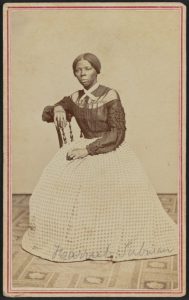 Many of the African American Spirituals were sung during the era of slavery. They were coded messages to one another. An example of this is the song Swing Low Sweet Chariot. It was reported that Moses, a conductor on the Underground Railroad whose real name was Harriet Tubman, would sing this song when approaching slaves on their plantations. Swing low meant that Harriet was swinging down through the south to invite the slaves to follow her to the north. The sweet chariot was the underground railroad. Coming to carry me home, meant that Moses was going to lead them to a new home in the north as free people.
Many of the African American Spirituals were sung during the era of slavery. They were coded messages to one another. An example of this is the song Swing Low Sweet Chariot. It was reported that Moses, a conductor on the Underground Railroad whose real name was Harriet Tubman, would sing this song when approaching slaves on their plantations. Swing low meant that Harriet was swinging down through the south to invite the slaves to follow her to the north. The sweet chariot was the underground railroad. Coming to carry me home, meant that Moses was going to lead them to a new home in the north as free people.
Some of the language used was implemented to throw off the slave owners. Such as the salvation of Jesus. Another song that Harriet Tubman would sing was Wade In The Water. It was a direction for those passengers on the Underground Railroad to get in the water and stay low. This was how they knew to hide from southern escaped slave hunters.
Abraham Lincoln would often frustrate his colleagues when he would call upon Frederick Douglass to ask him questions about his opinions. Truly Lincoln saw the value of all human beings. His tragic end prevented him from doing much more than what he had already accomplished.
Rosa Parks was arrested for not sitting in the back of the bus. But a part of that history that is often lost is that she had words with the same bus driver ten years before the back of the bus incident. She just became tired of a system that was not working for her. Releasing that which no longer served her. During that time period in the deep southern states of the U.S. if you were black and were sitting in a seat. Then a white person boarded. You were required to give up your seat and move to the back of the bus. This would continue as more White Folk boarded the bus all the way to the very back. Leaving those with African bloodlines standing on the bus.

America has come a long way in dealing with its need to recognize African Americans as equal. We still have a very long journey ahead of us. I am amazed that we have had an African American President serve for two terms. Barak Obama was just what the country needed at the right time. There were many who helped pave the way for our former President. People like Benjamin Lay would plant the seed for all Quakers to reject being slave owners and become abolitionists. Frederick Douglass would not sit down but continued to speak out often. Harry Reed believed in freedom. Did his part in putting a thumbprint on American history. Moses, Harriet Tubman was an incredible freedom fighter who risked her life over and over again to free her people. All the while fooling the south into believing that Moses was a man. Rosa Parks just became fed up one day and sat down. She had enough.
Part II
There is so much knowledge in the world. I encourage you dear reader to look these things up for yourself. To digest the information and retain it. It is important, not to dwell on the past. But to understand the present. Why there are certain attitudes and patterns emerging in our culture. We reach into the past to comprehend why groups like Black Lives Matter are so important to our understanding of what our Brothers and Sisters with African Heritage deal with on a daily basis.
Martin Luther King Sr.
December 19, 1899 – November 11, 1984
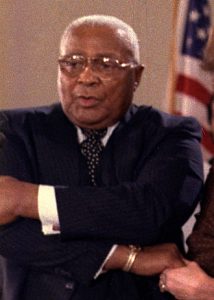 Martin Luther King Senior was the son of a preacher. He was named Michael King, he would change it later to Martin Luther King. He was impressed with the sites dedicated to Martin Luther in Germany. He would change his son's name from Michael King Jr to Martin Luther King Jr. Martin Luther King Sr was heavily intrigued by the trend within the Black Baptist Churches to be laboriously involved with the pushing for racial equality. While boarding with The Reverend A.D. Williams. King would meet his future wife, Alberta. King would ask for her hand in marriage. But her parents desired that King complete his ministerial training. He did exactly that and married his sweetheart Alberta too.
Martin Luther King Senior was the son of a preacher. He was named Michael King, he would change it later to Martin Luther King. He was impressed with the sites dedicated to Martin Luther in Germany. He would change his son's name from Michael King Jr to Martin Luther King Jr. Martin Luther King Sr was heavily intrigued by the trend within the Black Baptist Churches to be laboriously involved with the pushing for racial equality. While boarding with The Reverend A.D. Williams. King would meet his future wife, Alberta. King would ask for her hand in marriage. But her parents desired that King complete his ministerial training. He did exactly that and married his sweetheart Alberta too.
He would become the Minister for Ebeneezer Baptist Church. His mentor The Reverend A.D. Williams had transitioned. Martin Luther King Sr was able to keep his Church alive during the depression years. Organizing many methods to raise money to cover the expenses. He served as one of the local committee members for the NAACP. He was the minister for Ebeneezer Baptist Church for over forty years. He had an incredible amount of respect within his community and was able to influence whites in his region. King Sr would write that his father had the biggest influence on him becoming a minister. He saw his father as one of the noblest people he ever knew and wanted to be like him.
Martin Luther King Jr.
January 15, 1929 – April 4, 1968
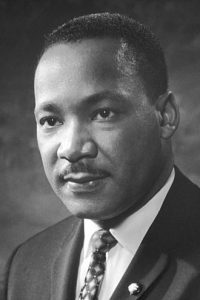 Martin Luther King Jr. was one of those types of people who had a vast amount of charisma and talent. Many believe that it was Mahatma Gandhi who had put Martin Luther King Jr on the path he chose. But truth be told it probably had to do more with his father's influence and his involvement in the racial disparities of his day.
Martin Luther King Jr. was one of those types of people who had a vast amount of charisma and talent. Many believe that it was Mahatma Gandhi who had put Martin Luther King Jr on the path he chose. But truth be told it probably had to do more with his father's influence and his involvement in the racial disparities of his day.
Martin Luther King Jr was a brilliant individual. Skipped two grades in his formulation years. Attended College for the first time at fifteen years old. He would become an ordained minister at eighteen years of age.
His ministry would become very powerful and influential. He would take his Christian principles and cleave them to the Gandhi method of non-violence. Creating a powerful message that would change the hearts and minds of many Americans concerning Civil Rights.
Martin Luther King Jr. was followed and spied upon on a consistent basis. J Edgar Hoover considered him an enemy of the state and added him to the FBI's watch list. It is alleged that J Edgar Hoover also implemented a harassment campaign. Including encouraging Dr. King to commit suicide.
Martin Luther would help in organizing many protests and marches to voice concerns over the Jim Crow south methods. Over time he was able to persuade many to recognize and see the need for racial equality. None of which would have been accomplished had these freedom fighters engaged the authorities with violence.
He won the Noble Peace prize at one point. In which he used the money as a support system to help further the civil rights movement.
He would meet a tragic end. His mind and thoughts were far too dangerous to many people. Martin Luther King is an amazing man of God, But the apple does not fall from the tree. His father planted those seeds deep within young Dr. King Jr. In such a way that he became a bright shining light throughout the lands.
Part III
In this section of this document concerning Black History Month. Our focus is on Women with African ancestors. During the Jim Crow era, there was tremendous racial separation and divide. It was difficult to be a Black Man in the deep south of the United States. But even more difficult for a Woman of Color to maneuver through society. A Black Woman had to do what was required of her from both the White separation and rules, but also the dogmatic overreach of the Black Man. Women were still very much considered weaker vessels.
In the Northern States, it is often assumed that there was far less racial divide. It was there too. Much of the way that Black Americans in the early 1900s coped was through Gospel Music. It allowed them to mourn, weep, and hope.
Sister Rosetta Tharpe
(March 20, 1915 – October 9, 1973)
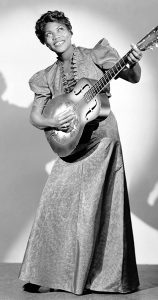 She was born in Cotton Plant, Arkansas to Katie Bell Nubin and Willis Atkins. Both of them were Cotton Pickers. Her father was a singer and she inherited his gift. Her mother Katie Bell was a stomp-down Christian. Meaning she loved to stomp her feet and clap her hands when in worship services. She could really celebrate her faith and that was placed deep within Rosetta's heart. Her mother had no fear and would perform to draw people into the church. Her mother was a traveling Evangelist and took Rosetta with her. Rosetta would eventually perform from on top of pianos in Churches. Her mother Katie Bell was in ministry in the Church of God in Christ. Because of this, young Sister Rosetta would gain great exposure.
She was born in Cotton Plant, Arkansas to Katie Bell Nubin and Willis Atkins. Both of them were Cotton Pickers. Her father was a singer and she inherited his gift. Her mother Katie Bell was a stomp-down Christian. Meaning she loved to stomp her feet and clap her hands when in worship services. She could really celebrate her faith and that was placed deep within Rosetta's heart. Her mother had no fear and would perform to draw people into the church. Her mother was a traveling Evangelist and took Rosetta with her. Rosetta would eventually perform from on top of pianos in Churches. Her mother Katie Bell was in ministry in the Church of God in Christ. Because of this, young Sister Rosetta would gain great exposure.
She was a Vocalist and musician. She could play guitar and piano. Her style heavily influenced Chuck Berry, Little Richard, Elvis Presley, Carl Perkins, Jerry Lee Lewis, and so many more. She would continue to influence many artists overseas like Eric Clapton, Jeff Beck, and Keith Richards.
Her mother did quite a bit of work in the Chicago region. Rosetta would be exposed to the early fusion of Gospel music and Jazz from New Orleans. It would help to fine-tune her ability to make a guitar shout while she sang her strong vibrant vocals. Her style would move traditional Gospel from mourning to singing with joy and soul.
"Tharpe's guitar style blended melody-driven urban blues with traditional folk arrangements and incorporated a pulsating swing that was a precursor of rock and roll."
Wikipedia
She would eventually travel around the United States in a Bus and may have been the first performer with their name on the side of the bus. She would book shows with both Black entertainers and White ones. Sometimes making people very uncomfortable. The bus was essential as in the deep south Sister Rosetta's entourage couldn't gain access to hotels and restaurants that were for whites only. the back of the bus had several bunks for sleeping.
She was loved by the black segregated soldiers serving in World War II. They could claim her as their own. It helped them while they were at war.
She had both male and female lovers during a time period where such a taboo was never discussed in public. One of her loves was a fellow performer Marie Knight. Together they would record. Both of them were multi-talented and did not need a band to back them up. Marie was a piano and percussion player. Rosetta was able to play piano and guitar. They would travel and perform together until Marie Knight's mother passed away. It would sink her into depression. Their relationship was primarily kept private, with the exception of the insiders in the entertainment industry.
Sister Rosetta Tharpe was a fierce force of nature that captivated the world.
Maya Angelou
April 4, 1928 – May 28, 2014
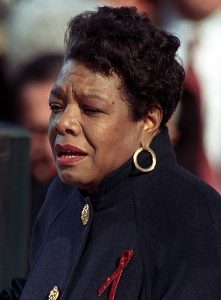 She was born Marguerite Annie Johnson. An American poet and civil rights activist. Born in St. Louis Missouri. Her older brother nicknamed her Maya which was short for "my sister." Maya's parents would have a terrible breakup and her father sent her and her brother to Stamps, Arkansas. To go live with her grandmother Annie Henderson. Annie did well during the depression. She had a General Store and people purchased much-needed commodities from her. She also had a shrewd business sense. Her grandmother taught her to celebrate life to the fullest and keep her messages handy throughout her life.
She was born Marguerite Annie Johnson. An American poet and civil rights activist. Born in St. Louis Missouri. Her older brother nicknamed her Maya which was short for "my sister." Maya's parents would have a terrible breakup and her father sent her and her brother to Stamps, Arkansas. To go live with her grandmother Annie Henderson. Annie did well during the depression. She had a General Store and people purchased much-needed commodities from her. She also had a shrewd business sense. Her grandmother taught her to celebrate life to the fullest and keep her messages handy throughout her life.
Maya had penned several autobiographies and poetry books. She is credited with a vast amount of plays and scripts. She was an actress and public speaker.
Later she and her brother would rejoin their mother in San Francisco. She won a scholarship to study dance and drama. She began to grow in her progressive political views. When she was quite young she was San Francisco's first African American cable car operator. When she was 16 she went back to school after a brief break from education. She would become pregnant with her son Guy. She would marry a Greek sailor, the marriage wouldn't last.
She was a recording artist and actress who belonged to the writers guild.
She lived in Egypt for a while, then moved to Ghana. She would return to the United States to help her friend Malcolm X. But that would not last long when he met his tragic end. When Martin Luther King Jr. was assassinated. Like many African Americans of the time period. She became very depressed.
She would write memoirs about her life. They became huge hits. In her later years, she would be read by a lot of white and black readers. Her first book "I know why the caged bird sings." spoke about her hardships and victories as a young girl growing up in a very racially segregated south.
Maya was an incredible force who believed that you should be a rainbow in someone else's cloud! She practiced love and light. Being an example of leadership, without being a leader. Many have been inspired by her amazing strength and courage. Her ability to master words and emotions in a moment when such things needed to be said and heard
Part IV
Tulsa Massacre 1921
The bloodbath lasted from March 31 to June 1, 1921. Was eighteen hours of terror a massacre of over three hundred Black Americans. The Greenwood district of Tulsa, Oklahoma was called the Black Wall Street by Booker T. Washington. It was a vibrant community of small businesses. The economic impact on the African American community was devastating. The entire series of events started when a young black man whose name was Dick Rowland was accused of assaulting A white woman whose name was Sarah Page. It is unclear what had happened but speculation of this event is that he had stumbled and fallen into her. He panicked and ran out of the building. Rowland would end up in jail, there were rumors that he was going to be lynched. To which the black community tried to find out. One of the elderly men tried to disarm the Law enforcement officer. He was shot and killed, then mayhem broke out. Very soon after that, the white community leveled the black community. Burning everything to the ground. There were around 300 souls murdered that day. There were many more hospitalized. It was a tragic event that would be whitewashed and not covered in the news. The event was buried. It was not until recently that the details and atrocities were uncovered and spoken of in the media. This is hands down a horrible racist event that took place in American history.
This event was most likely fueled by the White population's fears of the economic success of its Black counterpart. There was much worry that if African Americans were successful financially they would start making demands of the Nation. Racial and Civil liberties would be challenged and that was terrifying to very prejudiced people.
I suspect though that this incident actually had begun years before as there were lynchings taking place on both White and Blacks during the 1917-1918 time period. Oklahoma was following A pattern that was happening across the United States. It is not an anomaly.
The 1968 Olympics
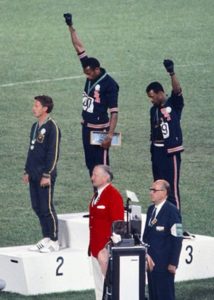 At the winner's ceremony which was the conclusion of the race. Two African Americans, Tommie Smith, and John Carlos would raise black-gloved fists in solidarity for the struggle of all African Americans. They would wear human rights badges on their jackets, as well as Australian third-place winner Peter Norman. This event was incredibly controversial for the time period. The reaction from the crowd was very negative. Both of the men would wear no shoes only his socks as a statement of economic poverty for most Negro people. Smith would wear a black scarf representing Black Pride. Carlos unzipped his jacket to show solidarity with the blue-collar workers. He also wore a necklace to represent slavery.
At the winner's ceremony which was the conclusion of the race. Two African Americans, Tommie Smith, and John Carlos would raise black-gloved fists in solidarity for the struggle of all African Americans. They would wear human rights badges on their jackets, as well as Australian third-place winner Peter Norman. This event was incredibly controversial for the time period. The reaction from the crowd was very negative. Both of the men would wear no shoes only his socks as a statement of economic poverty for most Negro people. Smith would wear a black scarf representing Black Pride. Carlos unzipped his jacket to show solidarity with the blue-collar workers. He also wore a necklace to represent slavery.
The Lessons Learned
What probably troubles me the most about the events that are labeled Black history. Is that all of this is our history. It is imperative that all people understand the events. So that we do not repeat the past in our future. The truly frustrating part of that is that we are seeing some of that bubbling up now in our current times. There has been an increase of White Power groups showing up on public display from the proud boys to the neo nazi movements. It is deeply vexing for me to witness in our current times. We need to have progress that goes beyond the attitudes of racism in public and private spaces. we must do as the Reverend Martin Luther King Jr. says in his book from strength to love. Have a Strong mental consciousness and very tender loving heart spaces. How can we make dramatic and drastic changes in our world? I have felt for a very long time that the best way to achieve this is with boots on the ground in our communities. That we are forever vigilant and watchful. That we continue the messages of Gandhi and Dr. King to move forward in non-violent communications and examples for the rest of the world.
Further Reading
Colonial Enslavement Of Native Americans
Slavery and Emancipation in the Nation's Capital
The White House And The Capitol Was Built by Enslaved Labor
Phillip Reed
American Moses - Harriet Tubman
Frederick Douglass
Rosa Parks
Martin Luther King Sr
Martin Luther King Jr
Sister Rosetta Tharpe
Legacy of Chicago's Bronzeville Neighborhood
Jim Crow Era
Maya Angelou
Malcolm X
Tulsa Massacre Of 1921
Tulsa Race Massacre
Lynching in Oklahoma
Case Of Reparations In Oklahoma
1968 Olympics Black Power Salute
Tommie Smith
John Carlos
Peter Norman

Document Created February 23, 2022
Document Created February 16, 2022
Document Created February 9, 2022
Document Created February 2, 2022